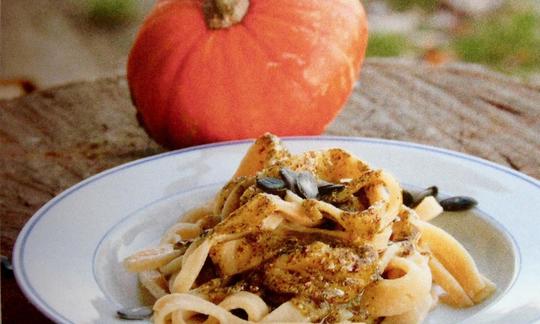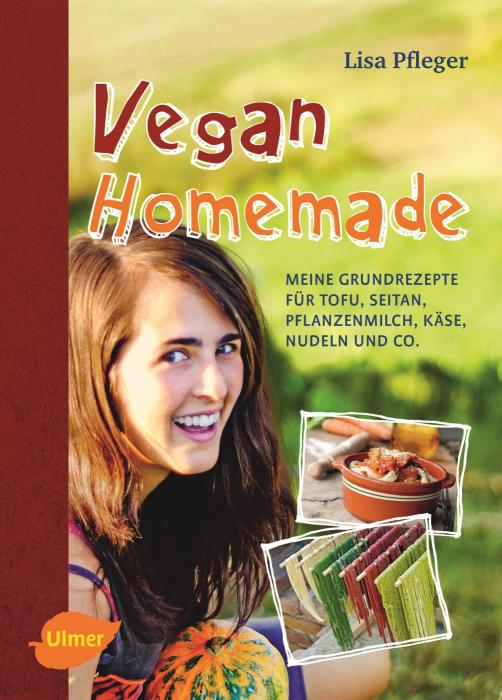Quick Pumpkin Seed Pesto with Pumpkin Seed Oil
vegan
Ingredients (for servings, )
| For the pesto | |
|---|---|
| 1 ¾ oz | Pumpkin seeds, roasted, without salt (pumpkin seeds) |
| 3 tbsp | Pumpkin seed oil, Styrian (cold pressed?, raw?, organic?) (1.4 oz) |
| ¼ tsp | Table salt (table salt, raw?, organic?) (0.05 oz) |
| 1 dash | Black pepper (organic?, raw?) (0.00 oz) |
Equipment
- shredder or blender or mortar
Type of preparation
- chop or grind
- food preparation without heating
- blend
Preparation
For the pesto
Grind the pumpkin seeds in a spice or coffee grinder. Add pumpkin seed oil, salt, and pepper to taste and grind again.If the pumpkin seeds aren’t roasted, it is best to roast them before grinding in order to improve the flavor of the pesto. You can also use a mortar and pestle or a high-speed blender. There is no pepper in the original recipe. You can decide for yourself if you want to add it
Seasoning and serving
Cook spaghetti or tagliatelle and top with the pumpkin seed pesto. If you would like, you can also garnish with pumpkin seeds.
|
Nutritional Information per person
Convert per 100g
|
2000 kcal | |
|---|---|---|
| Energy | 323 kcal | 16.1% |
| Fat/Lipids | 33 g | 46.4% |
| Saturated Fats | 5.7 g | 28.6% |
| Carbohydrates (inc.dietary fiber) | 3.7 g | 1.4% |
| Sugars | 0.32 g | 0.4% |
| Fiber | 1.6 g | 6.6% |
| Protein/Albumin | 7.5 g | 14.9% |
| Cooking Salt (Na:295.2 mg) | 750 mg | 31.2% |
| Essential micronutrients with the highest proportions | per person | 2000 kcal | |
|---|---|---|---|
| Fat | Linoleic acid; LA; 18:2 omega-6 | 15 g | 148.0% |
| Min | Manganese, Mn | 1.1 mg | 57.0% |
| Prot | Tryptophan (Trp, W) | 0.14 g | 57.0% |
| Elem | Phosphorus, P | 294 mg | 42.0% |
| Elem | Magnesium, Mg | 138 mg | 37.0% |
| Sodium, Na | 295 mg | 37.0% | |
| Min | Copper, Cu | 0.32 mg | 32.0% |
| Vit | Vitamin K | 24 µg | 32.0% |
| Prot | Phenylalanine (Phe, F) | 0.43 g | 28.0% |
| Prot | Threonine (Thr, T, irreversibly transaminated) | 0.25 g | 26.0% |
Detailed Nutritional Information per Person for this Recipe
The majority of the nutritional information comes from the USDA (US Department of Agriculture). This means that the information for natural products is often incomplete or only given within broader categories, whereas in most cases products made from these have more complete information displayed.
If we take flaxseed, for example, the important essential amino acid ALA (omega-3) is only included in an overarching category whereas for flaxseed oil ALA is listed specifically. In time, we will be able to change this, but it will require a lot of work. An “i” appears behind ingredients that have been adjusted and an explanation appears when you hover over this symbol.
For Erb Muesli, the original calculations resulted in 48 % of the daily requirement of ALA — but with the correction, we see that the muesli actually covers >100 % of the necessary recommendation for the omega-3 fatty acid ALA. Our goal is to eventually be able to compare the nutritional value of our recipes with those that are used in conventional western lifestyles.
| Essential fatty acids | per person | 2000 kcal |
|---|---|---|
| Linoleic acid; LA; 18:2 omega-6 | 15 g | 148.0% |
| Alpha-Linolenic acid; ALA; 18:3 omega-3 | 0.12 g | 6.0% |
| Essential amino acids | per person | 2000 kcal |
|---|---|---|
| Tryptophan (Trp, W) | 0.14 g | 57.0% |
| Phenylalanine (Phe, F) | 0.43 g | 28.0% |
| Threonine (Thr, T, irreversibly transaminated) | 0.25 g | 26.0% |
| Isoleucine (Ile, I) | 0.32 g | 25.0% |
| Leucine (Leu, L) | 0.60 g | 25.0% |
| Valin (Val, V) | 0.39 g | 24.0% |
| Lysine (Lys, K, irreversibly transaminated) | 0.30 g | 16.0% |
| Methionine (Met, M) | 0.15 g | 16.0% |
| Vitamins | per person | 2000 kcal |
|---|---|---|
| Vitamin K | 24 µg | 32.0% |
| Vitamin B3 (Niacin) | 1.1 mg | 7.0% |
| Vitamin B9, B11 (Folate, as the active form of folic acid) | 14 µg | 7.0% |
| Vitamin B2 (Riboflavin) | 0.04 mg | 3.0% |
| Vitamin B7 (Biotin, ex vitamin H) | 1.2 µg | 3.0% |
| Vitamin B1 (Thiamine) | 0.02 mg | 2.0% |
| Vitamin B5 (Pantothenic acid) | 0.14 mg | 2.0% |
| Vitamin B6 (pyridoxine) | 0.02 mg | 2.0% |
| Vitamin C (ascorbic acid) | 0.45 mg | 1.0% |
| Vitamin E, as a-TEs | 0.14 mg | 1.0% |
| Vitamin A, as RAE | 0.01 µg | < 0.1% |
| Essential macroelements (macronutrients) | per person | 2000 kcal |
|---|---|---|
| Phosphorus, P | 294 mg | 42.0% |
| Magnesium, Mg | 138 mg | 37.0% |
| Sodium, Na | 295 mg | 37.0% |
| Potassium, K | 198 mg | 10.0% |
| Calcium, Ca | 13 mg | 2.0% |
| Essential trace elements (micronutrients) | per person | 2000 kcal |
|---|---|---|
| Manganese, Mn | 1.1 mg | 57.0% |
| Copper, Cu | 0.32 mg | 32.0% |
| Zinc, Zn | 1.9 mg | 19.0% |
| Iron, Fe | 2.0 mg | 14.0% |
| Selenium, Se | 2.4 µg | 4.0% |
| Fluorine, F | 0.03 µg | < 0.1% |
| Iod, I (Jod, J) | 0.68 µg | < 0.1% |
"Vegan Homemade" features over 220 uncomplicated recipes with simple ingredients. Basic recipes for making vegan staples at home and for storing.
Since this book is written in German, a description is omitted here. If you are interested, please switch to German in the menu.
This pumpkin seed pesto with pumpkin seed oil is not only quick and easy to prepare. It’s also healthy and tastes delicious. Bear in mind, however, that pumpkin seed oil has an extremely poor ratio of omega-6 (inflammation-promoting linoleic acid) to omega-3 fatty acids (anti-inflammatory alpha-linoleic acid). We don’t recommend consuming large quantities of pumpkin seed oil.
Pumpkin seed oil: Pumpkin seed oil is made from roasted pumpkin seeds. It is usually used in salads and drizzled over fresh and warm dishes. It is also an ingredient in some desserts.
Pumpkin seed made from Styrian oil pumpkins (Cucurbita pepo var. styriaca) is an Austrian specialty. It has a dark greenish-brown color and an aromatic nutty flavor.
When heated above 100 °C, pumpkin seed oil loses its greenish color, flavorsome taste, and some of its healthy nutrients. Its healthy fatty acids change into trans fats and it may develop unhealthy bittering agents.
According to the Swiss Federal Office of Public Health (FOPH), a healthy ratio of omega-6 to omega-3 fatty acids should not exceed 5:1. See this article about avoidable nutrition mistakes.
Like with all oils, we recommend consuming pumpkin seed oil in moderation.
Storing: Pour the pumpkin seed pesto into sterile jars and cover with a layer of oil. When stored like this, the pesto can be kept in the refrigerator for several weeks.
Adding tomatoes: You can add cocktail tomatoes to give the dish an extra light, fresh flavor. Cut into quarters and add them to the dish.
Seasoning: In addition to pepper, you can season the pesto with garlic and a dash of lemon. This brings out the flavor of the pumpkin seeds.




